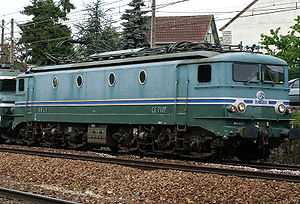Paul Arzens
Paul Arzens (1903–1990) was a French industrial designer of railway locomotives and motor cars.
Arzens was born in Paris, at an address along the Boulevard des Batignolles on the northern side of the city.[1] As a young man he studied at the École des Beaux-Arts and soon gained recognition as a talented artist able at this stage, unusually, to live reasonably well on the sales proceeds from his paintings.[1] This gave him enough time to pursue other interests in the realms of engineering and design. As his life progressed he accumulated a large collection of his own paintings and gained a reputation for an acute reluctance to sell any.
Cars
In 1935 Arzens turned his interests to automobile engineering. He designed and constructed a six-speed automatic transmission which he installed in an old Chrysler and which worked.[1] Robert Peugeot tried the car and was impressed, although hopes that the system might be adopted for the Peugeot 402 came to nothing, possibly because Peugeot had recently signed a deal with Cotal involving their pre-selector transmission.[1]
Two years later Arzens came up with an eye-catching and streamlined two seater cabriolet prototype body built around the chassis of an old Buick.[1] The car was christened "La Baleine" (the whale).[1] With its integrated headlights, panoramic curved windscreen (of "plexiglas") and proto-ponton format styling the design anticipated sports cars of the 1950s and 1960s. The car subsequently joined the Bugattis of the Schlumpf Collection at what has become the National Motor Museum in Mulhouse.
Two years later, following the German invasion, and the virtual disappearance of petrol for civilian use, Arzens came up with a second Baleine, closely resembling the first at least from the outside, but based on the chassis of an old Fiat - much lighter than a Buick - and encumbered by 1,100 kg of accumulator batteries.[1] This was an electric vehicle with a claimed 10 hp providing a range of more than 200 km (125 miles) at 65/70 km/h (approx 40 mph).[1]
Arzens' next automotive one-off appeared in 1942 and was instantly christened "L'Oeuf" (the egg), reflecting it's egg-shape. Other eye catching features were the tiny wheels and the high proportion of the bodywork formed of curved transparent plexiglas.[1] The body itself weighed just 60 kg, although adding the electric rear mounted motor raised this to 90 kg.[1] Once batteries were added the vehicle weight was increased to 350 kg, allowing for a range of 100 km (63 miles) at 70 km/h (44 mph) or at 60 km/h 37 mph if two people were on board.[1]
Rail locomotives

In 1947 Paul Arzens was placed on the payroll of the French National Railway Company (SNCF) and his first commission for them dates from that same year.[1] Arzens was behind the designs of the BB and CC locomotives and their numerous derivatives which would together dominate the French railway network during the 1950s, 1960s and 1970s.[1]
One of his earlier designs was for the smooth fronted CC7100 series. It was one of these, the CC7107, which broke the electric train speed record in 1955. The record would stand until broken by a TGV in 1981. Arzens was also behind the reverse sloping front window characteristic of locomotives such as the BB15000, which he said had been inspired by the form of a "sprinter on the starting block".
Sources and further reading
External links
- Picture of Paul Arzens at Ferropedia
- thumb painting of Paul Arzens: Baie de Bénodet at Artnet
- 3wheelers
|